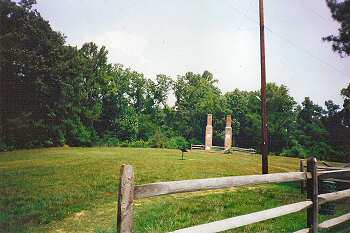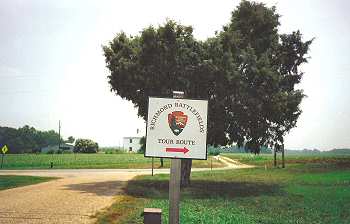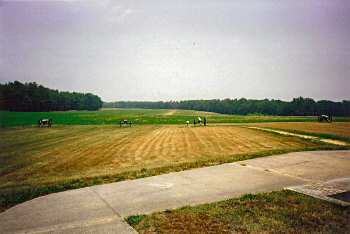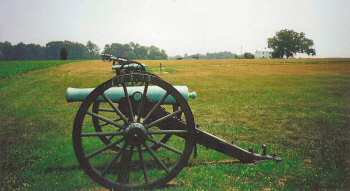|
(7-05)
Close-up
Seven Days Battles:
Malvern Hill
This photo shows the remains of the Methodist Parsonage. The chimneys were
prominent so they could easily be seen by Union gunners on the crest of
Malvern Hill on July 1, 1862 and still can be clearly seen from the
cannons mounted in front of the West Farmhouse
If you look closely it is possible to see the foot path which eventually
leads to cannons at the NPS Confederate artillery tour stop just off
Carter's Mill Road which are impossible to see due to the trees. D. H.
Hill's men came from the left of the chimneys, while Jackson's men came
from across the Willis Church Road (Route 156) further to the right of the
chimneys |
|
(7-05) Seven Days Battles:
Malvern Hill
This photo was taken from
driveway at the National Park Service (NPS) Malvern Hill exhibit shelter.
The white building in the background is the West Farm House which very
closely resembles the original wartime structure. The Richmond
Battlefields Tour Route sign is an example of the helpful signs. Roads
meander, change names and numbers, so these signs are a big help |
|
(7-05) Seven Days Battles:
Malvern Hill
This photo is from the National Park Service (NPS) exhibit shelter at
Malvern Hill. From this position you can see the open ground over which
Confederate troops charged against Union troops of George Morell's
Division of Fitz-John Porter's Corps. There are some informational signs
and an audio program here. The photo is just left of the center of the
Union line that stretched about 3 miles in the shape of an inverted "U".
The heart of the Federal defense was an array of cannon spread across the
Northern slope whose guns overlooked the large fields in front. So strong
was the position that no Confederates reached the cannons. The NPS has
placed some artillery pieces here to represent the Union artillery line.
Just out of view to the left is the privately-owned Crew House |
|
(7-05) Seven Days Battles:
Malvern Hill
The six 12lb guns of Battery "A", 5th US Artillery under command of Lt.
Adelbert Ames during the afternoon of July 1, 1862 fired 1392 rounds of
shell and canister. Most devastating was the canister (Shotgun-like blasts
of small iron balls fired usually at short range). The Confederate
infantry lines melted away under the barrage. No Southerners reached the
guns. Across the Willis Church Road from the guns you can see the West
farmhouse.
It should also be noted that during the battle many more cannon were in
use and the statistics about the six cannons of Battery "A", 5th US
Artillery are taken from the small interpretive marker visible behind the
guns
|



